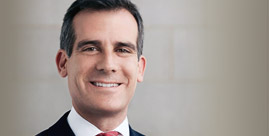
Eric Garcetti
Mayor, City of Los Angeles
Los Angeles is building the model city of the 21st century. We’re envisioning tomorrow, building it today, and doing it with our people as our foundation and motivation.
LA is home to the most diverse collection of individuals ever assembled in one place: Angelenos come from more than 140 countries and speak more than 90 languages and dialects.
That incredible diversity—and 235 years of history—have made us resilient and forward thinking. We don’t run from our challenges; we embrace them. We don’t shy away from opportunities; we reach for them.
Today, we are investing billions to modernize our infrastructure. We’re the green technology capital of the world. We’re creating open space to preserve a natural heritage unlike any other, and we’re expanding public transit from the coast to the valleys—and everywhere in between. We’ve also worked hard to widen the circle of opportunity in Los Angeles by raising the minimum wage and launching a program to offer one year of free tuition at our community colleges.
This period of historic progress is accompanied byprofound demographic change in our city. Angelenos have always been among the most diverse people on the planet, and are now living longer: more than half a million LA residents are over the age of 60, and that figure is expected to increase by 50 percent over the next two decades.
As mayor, I welcome this trend: it means we have a growing number of people with the wisdom and experience to help guide us into the future—in our classrooms, our workplaces, and even at City Hall. I also see an opportunity to build a city that works for everyone, because age should never be a barrier to accessing and enjoying all that Los Angeles has to offer. That’s why I am committed to taking action today to accommodate the needs of older Angelenos now and into the future—and making sure that seniors are part of that decision-making process.
Los Angeles is a part of the AARP Network of Age-Friendly Communities and the World Health Organization’s Global Network of Age-Friendly Cities. Last May, we strengthened that commitment when I signed an Executive Directive on Purposeful Aging. The directive requires all of our city departments to thoroughly consider the needs of older adults—and the challenges they often face, such as impaired physical mobility and diminished sensory awareness—when creating programs and policies. I also formed a Task Force on Purposeful Aging, which is made up of city departments whose work directly affects the lives of older Angelenos; it will create a strategic plan for an age-friendly Los Angeles.
That means taking action in ways that people can see and feel in their everyday lives. For example, our Economic and Workforce Development Board is developing a blueprint to better connect older Angelenos to new employment opportunities. We’re building out our transportation system and taking special care to keep fares low for seniors, who are frequently on fixed incomes but increasingly reliant on public transit. Our Housing and Community Investment Department is identifying affordable housing units for older adults. LA’s Recreation and Parks Department is ramping up the number of senior wellness programs available in every community. The Bureau of Street Services and Department of Aging have teamed up to assess the condition of streets in neighborhoods with a high density of older adults, with a particular focus on corridors with the greatest need for street furniture and shade structures. And Vision Zero—our effort to put an end to traffic deaths in LA—will identify which intersections are most dangerous for older adults, so that we can make targeted improvements that can save lives.
Mobility is such a big part of life in Los Angeles and our transportation authority, Metro, always takes care to consider the needs of older adults who use mass transit. Our buses are designed to accommodate all types of wheelchairs, are equipped with ramps for easier boarding, and have spaces to secure wheelchairs and walkers. Every one of our trains and buses has space set aside for older adults and customers with disabilities. And for those who have spent most of their lives behind the wheel, the newly expanded On the Move Rider’s Club is dedicated to teaching older adults how to rediscover Los Angeles on public transit.
All of these efforts are moving us forward in a city where older adults are already treasured and active participants in our civic landscape. The evidence is everywhere: last year, more than 1,200 older adults volunteered at our public libraries sharing their wisdom with younger Angelenos and enriching our city by fostering better understanding between generations. LA is home to 16 multipurpose senior centers that provide legal assistance, health and nutrition services, and other resources—in several languages, including Spanish, Mandarin, Korean, and Tagalog—to help improve seniors’ quality of life.
This is incredible, life-changing work to make sure that LA continues to be a safe, prosperous, livable, and well-run city for everyone. And I can’t wait to do more—because this should always be a place where the years are a benefit, not a burden.
about the author
Eric Garcetti is the 42nd Mayor of Los Angeles. His "back to basics" agenda is focused on job creation and solving everyday problems for LA residents. Garcetti was elected four times by his peers to serve as President of the Los Angeles City Council from 2006 to 2012. From 2001 until taking office as Mayor, he served as the Councilmember representing the 13th District which includes Hollywood, Echo Park, Silver Lake, and Atwater Village—all of which were dramatically revitalized under Garcetti's leadership.